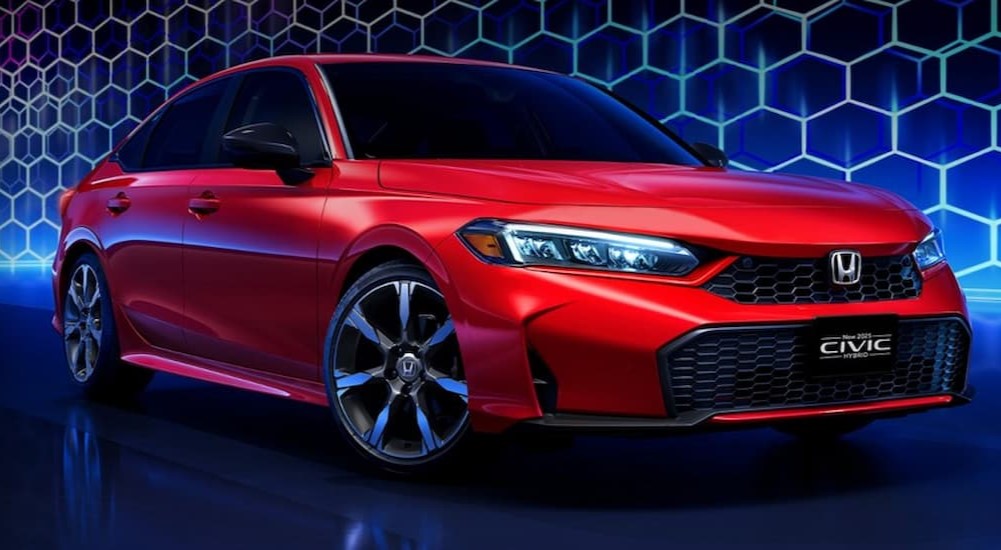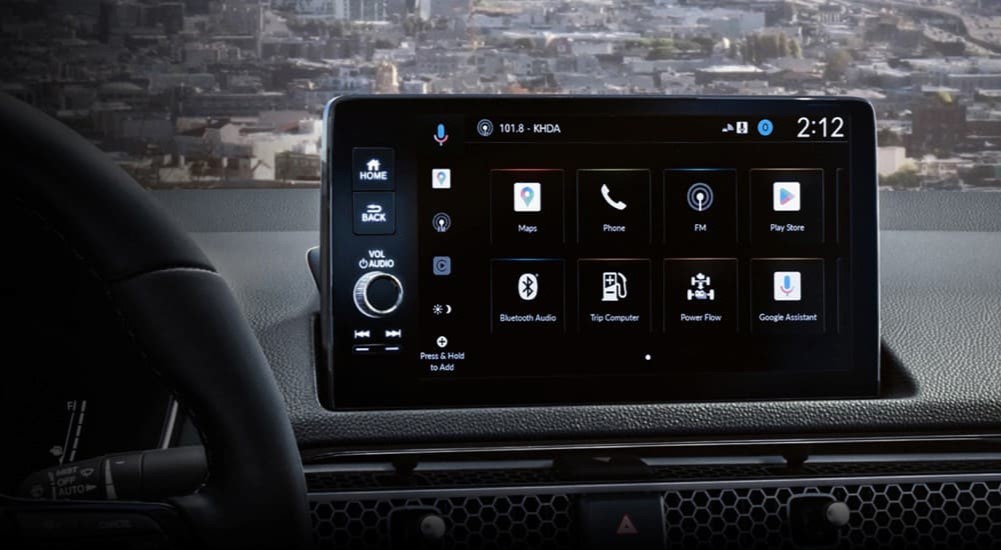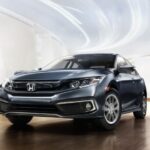Honda’s history of developing hybrids has been interesting. Every major automaker has tried to make hybrids, and Honda’s efforts have been a bit reserved, with a lot of false starts, brief stops, and revivals. While Ford and GM have made bold pledges to create hybrid versions of popular nameplates, and Toyota leads the charge, Honda has been slower to adapt their popular nameplates—but that is changing, and the 2025 Honda Civic Hybrid is proof of it.
Honda is re-embracing the hybrid ecosystem with their e:HEV architecture, which is currently utilized in the CR-V and Accord. But there’s a reason I say they’re “re-embracing” the hybrid ecosystem, because this isn’t the first time that the Civic and its hatchback variants have been treated to hybrid tech. In fact, Honda has dabbled in hybrid culture off and on throughout the years, giving shoppers looking for a hybrid Honda Civic for sale a bit of a runaround. But this time, it looks like they are going to commit to it full-time.
Before e:HEV Came Integrated Motor Assist
For newer-generation models, the e:HEV powertrain technology is all the rage, but before we got there, Honda experimented with Integrated Motor Assist (IMA). This tech combined a 1.0-liter three-cylinder combustion engine with a 10-kW electric motor, which worked as a semi-generator and starter as well, replacing the need for an alternator; this was a key factor in its design because it would later become the blueprint for Honda’s newer hybrid vehicles.
The IMA design was first implemented in the Honda Insight, a subcompact two-door liftback, in 1999. The Insight was the first proper mass-marketed, economy-class hybrid sedan, beating Toyota’s Prius to the market by just six months. Much like other hybrid designs, the IMA featured regenerative braking and was devoid of a plug-in system, so the Insight could get great fuel economy without having to rely on plug-in technology.
Due to the extremely lightweight aluminum and plastic design of the Insight, an aerodynamic exterior, and the combination of the internal combustion engine with the IMA hybrid technology, the Insight was capable of achieving an extremely impressive 70 MPG combined.
Time for a New Generation of Hybrids
Despite its innovative design, the Insight was not a popular vehicle. Honda noticed the lackluster market reception of the Insight, and production came to a halt in 2006. However, they briefly introduced a hybrid Honda Civic in 2003; they also introduced a hybrid Accord in 2005. The 2003 Civic Hybrid featured the same IMA technology as the Insight, with a battery pack in the rear and an electric motor between a 1.3-liter i-DSI four-cylinder and the transmission, making 93 hp and 116 lb-ft of torque.
The 2005 Accord Hybrid elevated the power output of the IMA platform, pairing an electric motor with a 3.0-liter i-VTEC V6. This marked the third generation of the IMA tech, with the Accord topping out at 255 hp thanks to the 12-kW electric motor and a dual-stage intake manifold with a lock-up torque converter. This was a vital step in helping Honda better its fuel-efficient technology, with improved and expected performance from its sedans and hatchbacks.
The Insight Was Reborn in the Honda Fit
The Insight may have been heralded as a breakthrough for the company by critics and environmentalists, but the market wasn’t all that keen on it. After Honda retired the subcompact in favor of experimenting with a hybrid Civic and Accord, it brought the Insight back in 2010. This time, the vehicle looked a lot more like a conventional five-door liftback sedan, offered two rows for up to five passengers, and featured the fifth generation of Honda’s IMA technology.
This Insight improved in every conceivable way, addressing many of the market concerns of the original by becoming more powerful, more efficient, and more appealing. This included upping the powertrain to a 1.3-liter inline four-cylinder hybrid paired with a 9.7-kW DC brushless motor, making 98 hp and 123 lb-ft of torque. The second-gen Insight also sported a continuously variable transmission (CVT).
The powertrain also facilitated driver feedback through the Honda Eco Assist System, making notes on driving styles to provide data about reaching optimal fuel efficiency. With the selectable Econ Mode, this vehicle would automatically sacrifice performance for fuel economy; this was the groundwork for what would become a standard drive mode across many of Honda’s vehicles.
At the same time, Honda introduced a hybrid Fit to the Japanese market as part of its second generation. It arrived in Europe in 2011 as the Jazz. This subcompact sedan shared the design ethos of the second-gen Insight insofar that Honda focused on making the Fit commercially viable by keeping its design small, sporty, and fun while focusing heavily on fuel economy. The Fit Hybrid leveraged the same tech as the Insight, running on a 1.3-liter inline four-cylinder paired with an electric motor, which managed to achieve 52 MPG combined.
Another attempt at an improved Civic Hybrid was made, with the sedan version receiving an alternative in 2011 as part of the ninth generation. This version of the Civic featured a 1.5-liter i-VTEC four-cylinder paired with a lithium-ion battery pack. The improvements of the IMA were clear, as Honda not only improved the appeal of the Civic but also improved its fuel economy with an EPA-estimated 44 MPG combined.
Honda Changes Their Approach With the CR-Z
At the same time that Honda reinvigorated its approach to hybrid tech with the new generations of the Fit, Insight, and Civic, it also experimented with a brand new nameplate: the Honda CR-Z. The CR-Z arrived initially in 2011 in Europe and in 2013 in North America, marking the sixth generation of the IMA. This was convenient for Honda because, a year later, they stopped production of the Insight for a second time, pulling the plug on the compact hybrid in 2014, followed by the Civic Hybrid being pulled from North America in 2015.
As for the CR-Z, it was just getting its start. This three-door subcompact was positioned as a sports coupe, taking Honda’s hybrid tech and applying it to performance. The result was a lightweight, sleek, and slight vehicle powered by a 1.5-liter i-VTEC inline four-cylinder, 15-kW DC brushless electric motor, and 600-watt lithium-ion battery pack. All this gave the CR-Z an output of 130 hp and 140 lb-ft of torque while managing 54 MPG combined.
What made the CR-Z unique was its CVT, but you could also have it with a six-speed manual transmission, which was unheard of for a hybrid. This helped to market the CR-Z to sports car enthusiasts who typically avoided hybrid models—but with the option of a manual transmission, there were hopes this model could tap the sports segment.
The CR-Z did win a bit of appeal at annual SEMA shows courtesy of Honda decking it out with motorsports kits. There were even MUGEN variants that popped up, showcasing just how cool a CR-Z could look with aftermarket mods. Honda even featured the CR-Z in several motorsports races to help bolster its appeal among racing fans. However, even with a lot of marketing support, the CR-Z was retired in 2016, as Honda planned an Accord Hybrid revival while welcoming the all-new Clarity.

Retiring the IMA Platform for the e:HEV
The ups and downs of Honda’s hybrids over the years helped this brand to eventually land on the current tech in its biggest nameplates: its new e:HEV platform.
While the IMA was instrumental in establishing Honda’s hybrids, the company decided it was time to move toward a more efficient, robust, and versatile platform they could employ across multiple segments—and that came with the 2014 Honda Accord. This was the first model to use the two-motor hybrid electric system, consisting of an Atkinson internal combustion engine, an electric generator, a motor, an intelligent power unit, and a power control unit.
Later, after some refinements, the 2019 CR-V used the third-gen e:HEV tech for a 2.0-liter four-cylinder paired with two electric motors, one of which helped with propulsion while the other operated as a generator. The engine and motors were tied to a lithium-ion battery, just like the CR-Z, but the difference is that the e:HEV platform removed the traditional transmission, alternator, and starter. Instead, the generator was a surrogate starter, and a dual-clutch system engaged the engine separately from the motors, allowing the motor to recharge the battery.
This design also enables vehicles like the CR-V Hybrid to achieve 43 MPG in the city and 36 MPG on the highway in front-wheel drive. Also, much like the Insight, e:HEV models such as the Accord Hybrid and CR-V Hybrid have multiple drive modes, including EV mode—so, in many ways, you can see how the trials and errors of the past helped Honda optimize the efficiency of their newer hybrid vehicles.
Honda Adds Some Jazz to the Mix
After the Accord and CR-V proved successful with the e:HEV platform, Honda tested the new design on a smaller model—the 2020 Jazz and Jazz Crosstar. This subcompact only appeared in Europe but is prided on forgoing electrical plugs for its hybrid design. Once again, the dual-clutch design for the internal combustion engine was key, and its drive modes helped maximize fuel economy.
Learning from that success, Honda made the 2022 Civic Hybrid, which debuted with the third-gen e:HEV tech. However, the Civic Hybrid was not made available in North America at that time; it would take a couple of years before Honda would be bold enough to bring a hybrid Civic back to North America after pulling it from the market in 2015.
The 2025 Honda Civic Hybrid and Beyond
The dual-clutch design could add a lot of appeal to a best-selling nameplate like the Civic, but will the new platform be enough to court hybrid-wary shoppers? Well, the newest 2025 Civic Hybrid embodies some of the exterior design motifs of the Civic Type-R, with aggressive, sporty, aerodynamic front fascia and Pirelli PZero performance tires, so that should surely help entice buyers.
Much like the CR-Z, Honda could be attempting here to use hybrid tech to attract sports car enthusiasts in addition to commuters and daily drivers. Nevertheless, it looks like Honda will keep refining its hybrid platform for some of its more popular nameplates until it finds the perfect formula. The big question is, does that hybrid formula appeal to the average Civic shopper? I guess we’ll find out with the 2025 Civic Hybrid…





